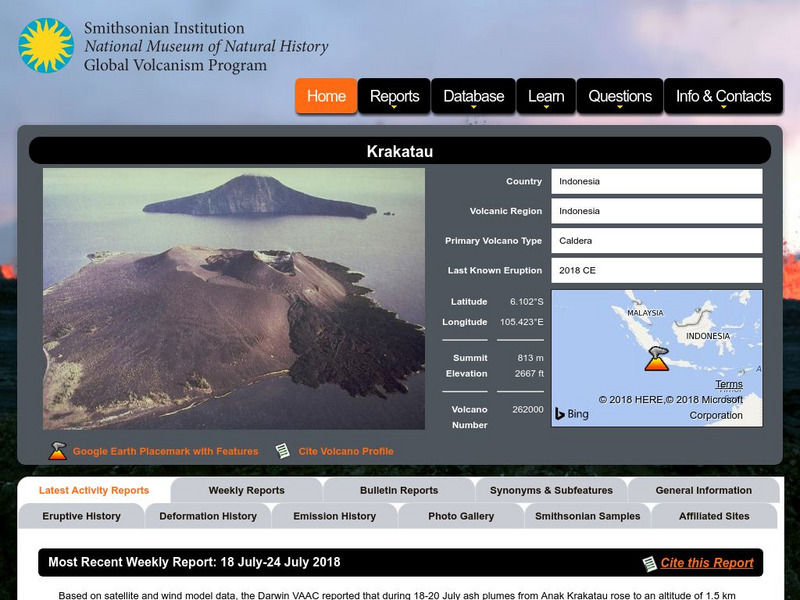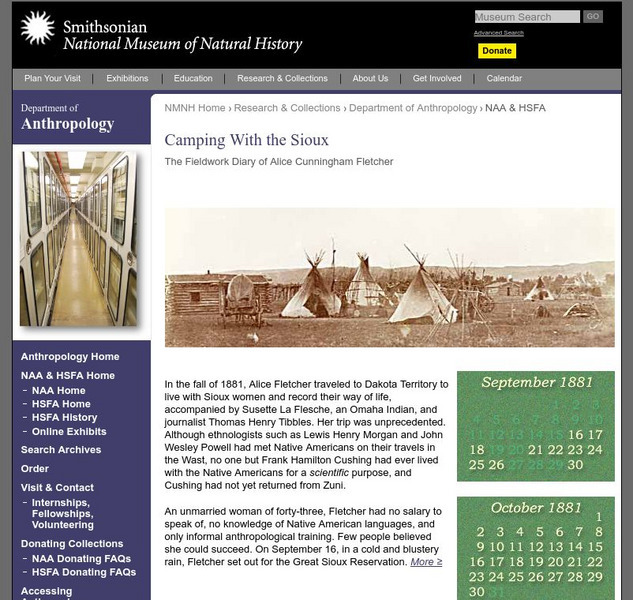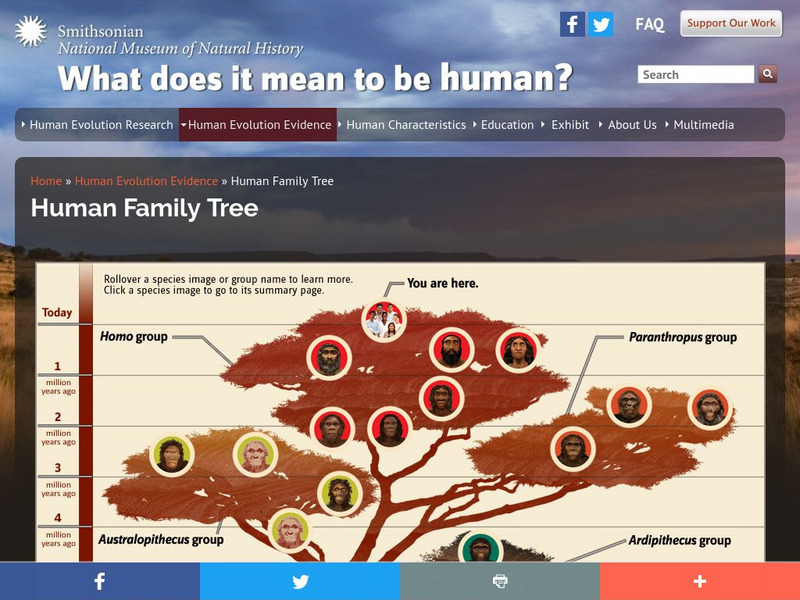Smithsonian Institution
National Museum of Natural History: Global Volcanism Program: Krakatau
The volcano Krakatau is in Indonesia. Learn about its background information, description, frequently asked questions, items of interest and useful links.
Smithsonian Institution
National Museum of Natural History: Zoo Labs
Five inquiry-based investigations designed for the observation of primates in a zoo setting. The labs ask guiding questions and list notable primate behaviors.
Smithsonian Institution
National Museum of Natural History: The Secret in the Cellar
The Secret in the Cellar is an interactive web comic based on the real finding of a body from the 17th century in the Chesapeake Bay area. Using historical and archaeological clues, students are guided to discover the truth about how...
Smithsonian Institution
National Museum of Natural History: Asustralopithecus Afarensis
This resource offers an excellent definition of the species, Australopithecus afarensis.
Smithsonian Institution
National Museum of Natural History: Does Our Background Shape Our Thinking About Environmental Issues? [Pdf]
A lesson where learners explore the positive and negative impacts of human activities on the environment today and in the distant past, and examine how attitudes towards the environment might be shaped by one's experiences growing up....
Smithsonian Institution
National Museum of Natural History: Relative Dating in Archaeology [Pdf]
Activities for the classroom that teach about stratigraphy and seriation, two methods used in the relative dating of objects in archaeology.
Smithsonian Institution
National Museum of Natural History: This Dynamic Planet
Research and explore past earthquake and volcanic activity on this interactive world map. User can manipulate which notable events and other map characteristics to view depending on the type of study being done.
Smithsonian Institution
National Museum of Natural History: Ocean Planet: Ocean Currents
The Ocean Planet exhibit at the Smithsonian explains the general features of ocean circulation. A general look at upwelling, deep water, and currents are combined for an overall view.
University of Florida
Florida Museum of Natural History: Identify a Florida Snake
This field guide to the snakes of Florida has everything you need to identify one, including drawings of scale patterns and excellent photographs, as well as how to recognize which ones are venomous. Also included is a section on how to...
Smithsonian Institution
National Museum of Natural History: Paleobiology: The Silurian Period
Journey into the past while reading this comprehensive overview of the Silurian Period that covers topics such as life in the seas, invasion of land, fossil evidence, and climate and geology.
Smithsonian Institution
National Museum of Natural History: Camping With the Sioux: Fieldwork Diary of Alice Fletcher
A fascinating site that presents the story of Alice Fletcher who traveled to Dakota Territory to live with Sioux women. Click on dates on the calendar for diary entries. Also includes historic photo gallery.
Idaho State University
Idaho Museum of Natural History: Guide to the Plants of Idaho State Arboretum
This resource describes the different plants of the Idaho State Arboretum in Pocatello. Users are provided with a picture and a description of every plant in the arboretum. You can click on the pictures for a larger view.
Smithsonian Institution
National Museum of Natural History: The Origin of the Genus Homo
The evolution of the Genus Homo is neatly laid out in a chronological fashion beginning with the key change that signaled the origin of Homo, through the evolutionary forms, finalizing with Homo sapiens.
Smithsonian Institution
National Museum of Natural History: Department of Botany
Visit the Smithsonian's Department of Botany, and search online from the specimen collection of nearly 800,000 plant specimen records. In addition, learn about research being conducted, activities and events hosted by the department,...
Smithsonian Institution
National Museum of Natural History: Ocean Planet
Detailed website that was a companion to a 1995 traveling exhibit of the Smithsonian. Links to lesson plans and other educational materials are at the bottom of the page. Enter the exhibition to explore the world of the ocean.
American Museum of Natural History
American Museum of Natural History: North American Ethnographic Collection
The Division of Anthropology was established at the AMNH in 1873, only four years after the founding of the museum. During its first 17 years, the department was concerned almost exclusively with the acquisition and display of artifacts....
American Institute of Biological Sciences
Action Bioscience: Natural History Museum Collections in the 21st Century
Discover why some people feel that natural history museums are more import now than they have ever been. Familiarize yourself with some of the challenges these museums are facing.
Smithsonian Institution
National Museum of Natural History: Human Origins: Human Family Tree
Find the human ancestor you are interested in and click on it either in the timeline or the list below for more details. Each fossil or reconstruction pictured includes links to more details about it.
Smithsonian Institution
National Museum of Natural History: The Canela Indians
Journey to Brazil and visit the Canela Indians. Learn all about their culture and view artifacts and video footage.
Smithsonian Institution
National Museum of Natural History: Ocean Planet: In Search of Giant Squid
An on-line exhibit archived from a Smithsonian exhibit explores and interprets the facts and myths surrounding giant squids - the world's largest invertebrates.
Smithsonian Institution
National Museum of Natural History: Written in Bone: Forensic Files of the 17th Century Chesapeake
This very thorough site will fascinate those interested in forensic anthropology. You will learn what you can read from bones, how a face can be reconstructed from a skull, clues you can read from a burial, and about forensic cases both...
PBS
Pbs Learning Media: Frames of Reference
Explore how different frames of reference affect your perception of motion in this interactive activity from the American Museum of Natural History.
Curated OER
A View on Cities: Washington: National Museum of Natural History
National Museum of Natural History (Washington)
Curated OER
A View on Cities: Chicago: Field Museum of Natural History
Field Museum of Natural History (Chicago)














